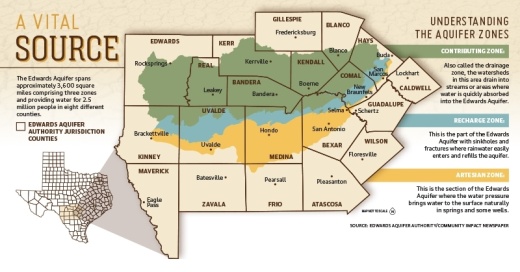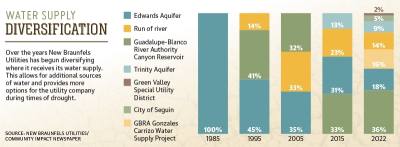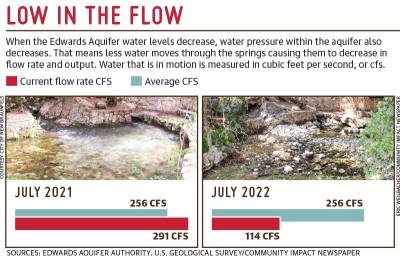New Braunfels Utilities has been in Stage 3 drought restrictions for 73 days as of publication, and water levels in the Edwards Aquifer dropped to levels not seen since 2014.
Cities across Central Texas may see increased drought restrictions in the future due to a lack of rainfall and high temperatures. New Braunfels has received about 7 inches of rain so far this year, which is 13 inches below the normal average, according to data from the National Weather Service.
More than 2.5 million people depend on the water from Edwards Aquifer, which has been named as one of the largest and most unique aquifers in the world by Texas Parks and Wildlife.
The J-17 Index Well in Bexar County is used to monitor and track water levels in the aquifer and correlates closely to flow levels from Comal Springs. The J-17 Index Well is over 23 feet below the historic average values for the summer months in the region, according to the Edwards Aquifer Authority.
It would take a significant amount of rain in the northwest region of Central Texas to allow drought restrictions to be lifted. If the area does not have any rainy seasons leading up to next summer, a dry climate will continue, according to EAA General Manager Roland Ruiz.
“Short of significant rainfall between now and the start of next year, we’re going to find ourselves where we are today, except earlier in the year,” Ruiz said. “Because we may not come out of any stage of critical period if we don’t have rainfall.”
NBU drought response
New Braunfels was free of drought restrictions from November 2021 until March 1, when Stage 1 water restrictions were declared due to the lack of sufficient rainfall. Previously, NBU declared Stage 2 restrictions on April 13. Stage 3 restrictions were enforced on March 10, limiting the amount of water that can be used by residents.
Current Stage 3 restrictions limit watering with a sprinkler or irrigation system to once every other week based on the last digit of one’s address before 10 a.m. or after 8 p.m.
Melissa Krause, chief strategic communications and security officer for NBU, said that it is important for New Braunfels residents to conserve water and adhere to Stage 3 drought restrictions. According to Krause, the biggest water user is with an irrigation system or sprinkler.••Increasing the amount residents water their grass during hot summer months will not bring grass back to life, but it will cause an increase in water bills, according to Krause.
“When grass turns to brown, it is not a signal that it has died; it signals that the grass has gone dormant,” she said. “This is a natural process; which means that it should return to its former state when temperatures begin dropping in the fall.”
Krause said that a team is working on deciding what Stage 4 drought restrictions may look like.
“Currently, that work is still underway, and our latest predictions indicate we could approach Stage 4 if we have no weather events on the horizon,” she said. “We were in the Stage 4 trigger level in 2014; however, we did not call Stage 4 due to forecasted rain events that actualized.”
The most significant historic drought in Texas took place in 1956, when the Comal Springs stopped flowing completely from June to November, Ruiz said.
“The drought that we had from 2011-14 started to look quite a bit like the drought of record [in 1956] in terms of intensity,” Ruiz said. “Some might say that it was even more intense than the 1950s; it just wasn’t as long. In the 1950s, that drought was—depending on who you ask—was either a seven- or 10-year drought.”
NBU Watershed Program Manager Mark Enders said he is concerned about the possibility of a prolonged drought and encouraged residents to conserve water when possible.
However, by utilizing additional water supplies from other sources, NBU may be able to maintain Stage 3 watering restrictions for residents but still decrease Edwards Aquifer usage, Enders said.
NBU officials partnered with the Guadalupe-Blanco River Authority in August 2019 to establish the One Water team, which identifies ways to preserve local water resources while the area experiences explosive growth.
According to NBU, its source of water has also diversified over the years. In 1985, 100% of the city’s water supply was from the Edwards Aquifer. In 2022, 18% of NBU’s water supply is from the Edwards Aquifer, with the GBRA Canyon Reservoir and Trinity Aquifer among other sources being utilized.
“[Some local] major users are not solely or wholly dependent on the Edwards [Aquifer]. They’ve expanded their water holdings, and it gives them greater latitude during times of drought like this to have more tools available to manage their various water resources,” Ruiz said.
The EAA and NBU are developing an aquifer storage and recovery project inside the Edwards Aquifer, which was passed through the Texas Legislature in May 2019.
Water conservation plans
As of August 23 flows at Comal Springs are at about 117 cubic feet per second when the long-term average flow is about 290 cfs, or about one-third of the average, according to Chad Norris, deputy executive manager of environmental science for the GBRA. Cfs is used to measure the pressure and motion of water.
The EAA declared Stage 4 of its Critical Period Management Plan to enforce permit reductions to the San Antonio region for the first time since 2014 on Aug. 13. The CPM went back to Stage 3 on Aug. 19 due to rainfall. The plan is put in place to help sustain aquifer and springflow levels during times of drought by temporarily reducing the authorized withdrawal amounts of Edwards Aquifer permit holders, which includes utility companies.
In Stage 4 of the plan, permit holders in Comal and Guadalupe counties must reduce their annual authorized pumping by 40%, and 35% in Stage 3.
Norris, who is a member of the Edwards Aquifer Habitat Conservation Plan Science Committee, said that when drought conditions are persistent or springflows reach a lower output, certain measures of the conservation plan are implemented.
“Some of those measures involve using alternative water sources, reducing reliance on the [Edwards Aquifer] itself,” Norris said. “And those are all designed to maintain spring flows and make sure that they don’t get below a threshold that we have identified as needed to reduce the impacts to [aquatic] species.”
The Comal and San Marcos springs help maintain base flows and are the two major springs that use the Edwards Aquifer and are tributaries to the Guadalupe River system.
“When we get into these drought conditions, and you don’t have rainfall driving stream flow, most, if not all, of the stream flow we see is derived from aquifers or released from lakes,” Norris said.
Norris said he expects some of the bigger impacts of the drought to be in the smaller tributaries in Texas that do not have springs to provide base flows.
“We have plans like the Edwards Aquifer HCP. Water providers have drought contingency plans; municipalities and others have drought measures that they take to reduce water use,” Norris said.”I feel like in general, we are prepared and not unaccustomed to droughts like we’re experiencing now. But with every drought, you’re always just waiting for the next rainfall.”
Economic impact
According to the NIDIS, Comal and Guadalupe counties are currently in an exceptional drought, the highest category of intensity for drought conditions. Widespread crop loss has been reported, and agricultural producers are not planting their fields.
"Not only is water in demand, but it’s increasingly difficult for the irrigation agricultural producers to just simply have enough water to keep water on their crops to remain viable,” Ruiz said.
Portions of the seafood, forestry, tourism and agriculture economic sectors in the region have reported significant financial loss, NIDIS officials said. According to the United States Department of Agriculture, on June 1 Texas crops of wheat were down 57% compared to 2021.
Shane Wolf, general manager and public relations director for Rockin’ R River Rides, said that the operations at locations on the Comal and Guadalupe Rivers have not been affected by this year’s drought. Due to the heat, Wolf said people are eager to cool off.
“The heat this year, as we’re all aware of, has actually probably offset any decline that we would have had due to the low flows,” Wolf said. “Good news is that we’ve got better flows than probably any other river at all in the state.”•










